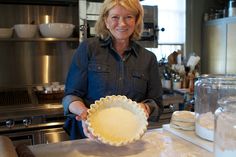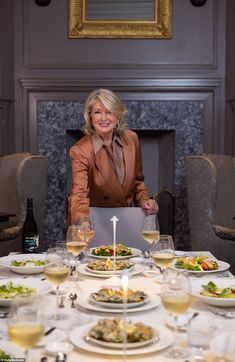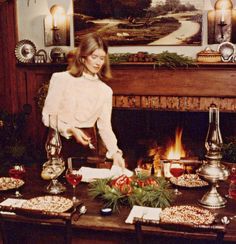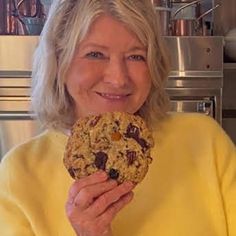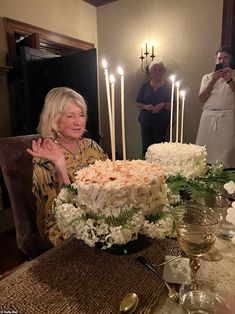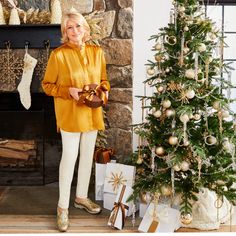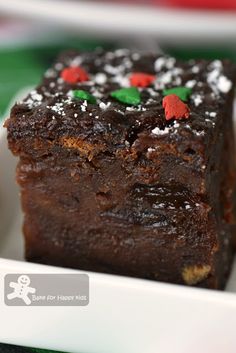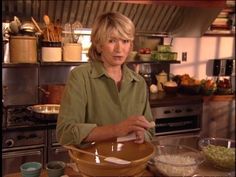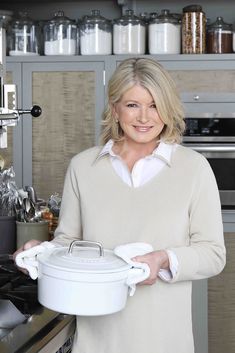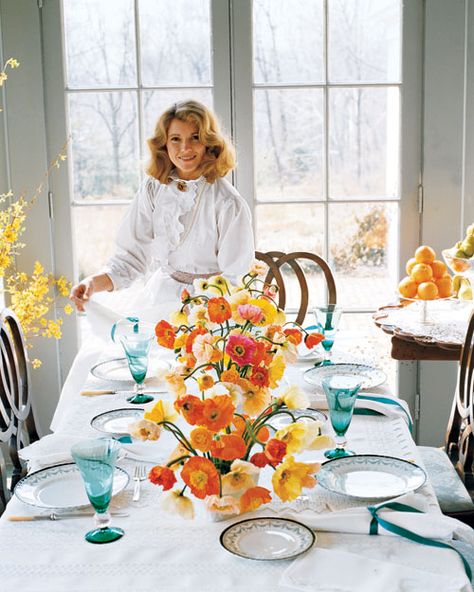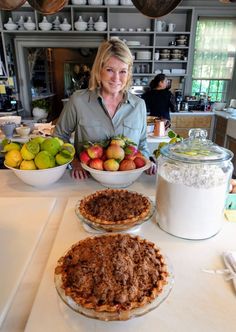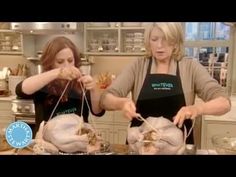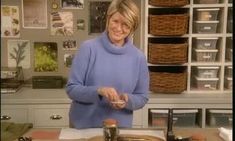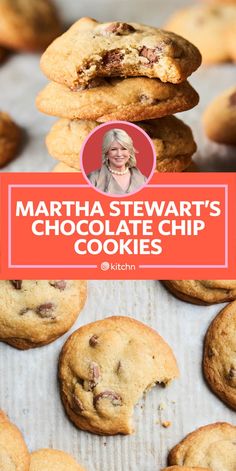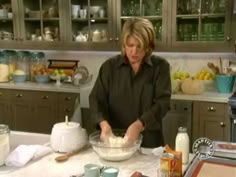Martha's Roasted Turkey with Stuffing | In this classic clip, watch Martha share her tried-and-true tips to making the perfect roasted turkey with stuffing. https://bit.ly/2UkFvRl | By Martha Stewart | You know, after years of creating turkeys with crusts of puff pastry and mosaics of sage under the skin, it occurred to me that I may have overlooked those of you who have never roasted a turkey and for those of you who have, I decided, well, I'll do an introductory or refresher course, Turkey 101. This will give you the best basic turkey you've ever tasted and a dressing, a stuffing that's really basic too but has a surprise ingredient, dried sour cherries. That'll make the stuffing taste really good. So, I'll show you how to make this first the stuffing and then we'll go on to roasting the turkey. For enough stuffing to stuff a 20 bird and have a little bit left over for a casserole, melt12 tablespoons of unsalted butter and add four large onions. I like to use a good sweet yellow onion or a white onion which is really sweet right into the melted butter. The onions coarsely chopped. Saute this until it's translucent. Just a couple of minutes. When you're making stuffing, it's really a good idea to have all the ingredients prepared ahead of time. After about two minutes, add 16 stalks of celery that have been finely chopped. You know, stuffing tends to keep the bird nice and plump looking and the stuffing really is enhanced by roasting it inside the bird. There's a lot of talk about the dangers of stuffing a bird and roasting it with the stuffing in it but if you're very careful and don't stuff the bird until right before you're ready to roast it and that the stuffing and the bird are the same temperature. You really don't have to worry. Continue cooking the celery, and the onion for about five minutes. Then, add 10 sage leaves that have been cut up. These are fresh sage leaves. Add about two teaspoons and let that cook five minutes and don't forget while you're preparing the stuffing to prepare a basic turkey stock using the giblets and the neck of the turkey with a little bit of white wine, onion, carrot, and celery and let that cook for a couple hours. That's going to be the moist that you add to the stuffing and now we can get two pounds of the most delicious white bread or peasant bread that you can find and this we call country bread from our local store in Westport called Heyday. Two pounds cut into good sized cubes. I'd say a little bit more than an inch cubed. Now, this looks perfect. It's a nice bright color. The celery is soft. The onions are soft. Add about a cup of stock and now transfer this mixture to half of the bread. You can just pick this up and pour it right in. Wish you were here. The smells are really good. Now, this will soften the bread. Add two bunches of parsley and the parsley should be the flat leaf variety which is very fragrant and finely chopped. Add the rest of your bread and you're going to add probably about five cups of stock all together to keep this nice and moist. Two teaspoons of salt, coarse salt, which I always use, the kosher variety, and add 4 teaspoons of freshly ground black pepper. You can look for tele cherry peppercorns. Whatever smells really good and fragrant. And now add about three more cups of stock to this. Add the stock and keep looking at your bread. You don't want it to be soggy and heavy with with stock. All you want it to be is moist and fluffy. There I've added about oh a little bit more than three cups and because this bread was so fresh, I'm not going to add anymore. You don't want it to be real soggy. If the bread were stale bread, it would use a little bit more but this looks great. It's not soggy. It's just the bread still has a little bit of its shape and now, two cups of dried sour cherries and one and 1 half cups of chopped fresh pecans. Now you can taste this and just check for the salt and pepper. Well, cool it off and get it into that bird because you know what? You can eat this whole bowl just as is it so good but now we'll go to roasting the bird. Well, here's our 20 pounder. It's a fresh-killed turkey. I prefer that to any other kind and it's been well washed Now, notice I'm using a piece of parchment paper which I prefer to washing the board. This is makes the cleanup really easy and this is where you stuff the cavity of the bird. This is where you put your most of the stuffing. You can also put some of the stuffing in the neck cavity which is right here with this large flap of skin. Also, salt and pepper lightly the neck cavity and the big cavity of the bird. When you're choosing a bird, think about how many guests you're going to have and my basic rule of thumb is one pound of turkey to one person. And now, a handful of stuffing. Now, don't stuff really tightly. You don't want the stuffing to erupt during roasting and crack the skin of the bird or break the ties on the legs. You just really want a nice, light, fluffy filling of stuffing. Smooth it out and then, with toothpicks or bamboo skewer, pull that neck flap just to fix the neck skin to the under part of the turkey. I'm pulling it toughly because you want a pretty bird. Now, these are the wings and if you want, turn the turkey over, breast side up, and bend the wing tips underneath the neck cavity. Like that so you see they're going to stay like that smooth out this portion of the bird and stuff the big cavity and then your stuffing by the handful again inserted into the opening And also when working with fresh poultry like this it's a good idea to rinse your hands right after doing the stuffing process after the washing process. Keep your hands clean. You can mount a little bit more and see I have plenty left for a lightly buttered casserole for those people who don't want to eat stuffing that's cooked in the bird. So that'll give at least eight helpings. Once the cavity is full enough of stuffing, tie the legs up to the tail and then you're ready to put it in the roasting pan. I use a nice cotton twine, nice strong string going around the tail once or twice and then around each drumstick once or twice pulling so that you create a nice round effect The plumper looking the bird I think the nicer. This is a Bill and Evans turkey at Thanksgiving time it might be difficult to find a fresh killed turkey if you haven't ordered in advance but if you have a good butcher like we do here in Westport several of them you can find a good turkey now notice I'm tying it in a bow so that after it's roasted I can just undo the bow and remove the string so now you're ready to put this bird into the roaster but first prepare your roasting pan I prefer using a nice shallow pan like this it's about three inches deep and large enough to hold the bird comfortably but not large. And in the bottom, stew some vegetables, peeled carrots, One onion. Peeled and quartered. Some parsnip. I love the taste of parsnip. Celery stock. Celery root, and some white turnip. And then place your rack right on top of the vegetables. And your turkey on top of the rack. Before you put this turkey in the oven, take a bit of softened butter and rub it all over the skin. One nice feature of this shallow roasting pan is that it exposes the maximum amount of bird to the dry heat of the oven and it'll cook that bird really well. Just rub this butter. You can use melted butter if you prefer. Two or three tablespoons will do. Now, remember, we have our basting liquid of three sticks of butter, three quarters of a pound to one bottle of a nice, dry white wine and then, for our final little hint, some of you may already know this. We're going to cover the entire surface of the bird with a quadruple layer of cheesecloth, cotton cheesecloth. The cheesecloth will keep the moisture in the bird and it will prevent the bird from getting too dark too quickly. Now, here's our quadruple layer of cheesecloth. Notice it's quite a nice big piece. Dip this into your butter and wine mixture. Looks like we're doing the laundry but really we're just going to protect this bird and make the roasting process really successful. Cover the bird with the cheesecloth. Covering all the exposed areas. And now it's ready to go. Into the oven 450 degrees for 30 minutes. Then you'll reduce the temperature to 350 and you will baste with this mixture every 30 minutes until the turkey registers 180 degrees on a meat thermometer. When the bird has one hour left to cook, give or take a few minutes and this is a 20 bird Estimated cooking time approximately four hours to four and a half hours. Take the bird out of the oven. Remove the cheese cloth. Oh wow, it's looking very beautiful. Give it one more basting of the hot basting liquid. And put it into the same 350degree oven one more hour. If you notice during the last hour of roasting that either the drumsticks or the breast are getting too dark, just overlay that area with a little piece of aluminum foil. You don't want to cover the whole bird but this prevents too much darkening. So now, back into the oven for one more hour or until your meat thermometer inserted into the thickest part of the leg registers 180 degrees. That's doing very well. We're almost a hundred and forty. And don't forget paste one more time. Well, during the last hour, I did cover the drumsticks and the front of the bird with foil but boy, does that look good? Lackery brown glistening. A turkey you'll be proud of and now, you have to let the turkey rest for about 20 minutes to a half hour before you carve it. That gives time for the juices just to settle into the meat. If you cut it while it's really hot, you'll notice a gush of juice. So, let it rest and then, while it's resting, prepare the gravy.
Cook Thanksgiving with Martha

Martha Stewart
We think you’ll love these
